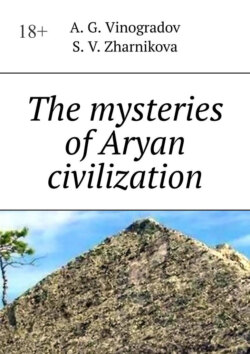Editor Алексей Германович Виноградов
Illustrator Алексей Германович Виноградов
Translator Алексей Германович Виноградов
© A. G. Vinogradov, 2025
© S. V. Zharnikova, 2025
© Алексей Германович Виноградов, illustrations, 2025
© Алексей Германович Виноградов, translation, 2025
ISBN 978-5-0065-5005-6
Created with Ridero smart publishing system
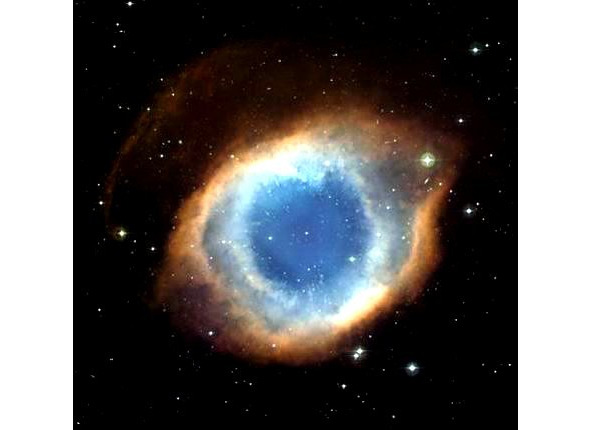
The book of outstanding researchers A. G. Vinogradov and S. V. Zharnikova is devoted to the study of the ancestral home of the Indo-European peoples: Indian, Iranian, Slavic, Baltic, German, Celtic, Romance, Albanian, Armenian and Greek language groups. Part six of this huge work is devoted to the mysteries of the land of the ancient Aryans. The book was written in 1989—90 but could not be published in Russia. Over the past time, additional materials have appeared that confirm the opinion of the authors.
Перевод осуществлен Виноградовым А.Г.
Иллюстрации взяты из издания книги «Загадки арийской цивилизации» на русском языке.
Translation by A.G. Vinogradov
The illustrations are taken from the Russian edition of the book «Загадки арийской цивилизации».
Introduction
In the modern world, the urgency of the problems of the ethnic history of the peoples of various regions of our planet is obvious. The growth of ethnic self-awareness, which has been observed everywhere in recent decades, is accompanied by an increase in interest in the historical past of peoples, in the transformations that each of them experienced in the course of its millennia-old formation. It became a spiritual need for a representative of a modern urbanized society to find the roots of his ethnic existence, to understand the diverse processes that led to the formation of that ethnocultural environment through which he perceives the world around him.
Since the origin and historical existence of the overwhelming majority of the peoples of our planet was associated with numerous migrations, movements to new habitats, causing changes in a number of cultural factors both among the alien people and the indigenous population, today, studying the ethnic history and culture of their people, we, of course, study them in the process of historical transformations and mutual influences of many tribes and peoples, which to one degree or another took part in their formation. Regional ethno-historical research in our time is becoming especially acute, since it is knowledge of the history of one’s own people that helps a modern person to free himself from the narrowness of the nationalist view of the world, to understand the role and significance of the contribution to the common treasury of human culture of all peoples, to realize that humanity is one.
Of course, it is impossible to solve the most difficult issues of ethnic history today without involving data from the most diverse fields of science. It is necessary to combine the efforts of ethnographers, historians, archeologists, linguists, folklorists, anthropologists, art historians, as well as paleobotanists, paleozoologists, paleoclimatologists and geomorphologists, since the development and formation of peoples took place in certain climatic zones, in certain landscapes, with a certain flora and fauna, and this must be taken into account.
Only if the questions posed by ethnic history will be given mutually supportive answers by all of the above branches of science, we can, with a certain amount of confidence, believe that we are close to a true understanding of a particular stage of the historical process. Therefore, at present, the search for an answer to any of the questions of the ethnic history of peoples cannot be considered legitimate without involving data from related sciences.
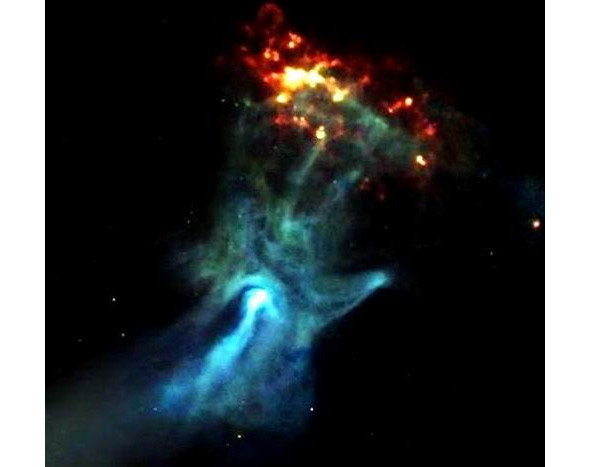
Viktor von Hen responded very interestingly in 1890 about Russian culture: «Russia is a country of eternal change and completely non-conservative, and a country of ultra-conservative customs, where historical times live, and does not part with rituals and representations, no matter how related. The modern culture here is an external gloss, it develops in a wave-like fashion, generates disgusting phenomena; what the Ancient Tradition has preserved with regard to goods, customs, tools, etc., has been invented solidly, rationally, wisely and skillfully used… They are not a young people, but an old one – like the Chinese. All their mistakes are not youthful flaws, but arise from asthenic exhaustion. They are very old, ancient, conservatively preserved all the oldest and do not refuse it. By their language, their superstition, their disposition, etc. you can study the most ancient times. " («Victor Hen, biography.» 1894.)
The Sanskrit texts that have come down to us contain many amazing puzzles related, first of all, to the ancestral home of the Aryans. Here I would like to recall again some of the characteristic features of this ancestral home, preserved by Mahabharata.
Chapter 1 Catastrophes of the stone age
1
Over Canada, Over Canada
The sun sets low.
I should have fallen asleep long ago
Why can’t I sleep?
The sky over Canada is blue
Between birches – slanting rains.
Although it looks like Russia,
Only still not Russia.
These words from the famous song of Alexander Gorodnitsky emphasize the fact of the amazing similarity of flora and fauna, separated by the oceans of eastern North America and Europe. Based on this fact, Alfred Wegener wrote in the book «The Origin of the Continents and Oceans»: «North America used to be close to Europe. Starting from Newfoundland, located close to Ireland, and further north, it was a single block with it and with Greenland».
This was emphasized by the fact that: «The consequences of the rupture of a single faunistic region should have been especially pronounced in North America and Europe, because the rupture occurred relatively late, and paleontological data are correspondingly numerous. In addition, these areas are especially well studied.
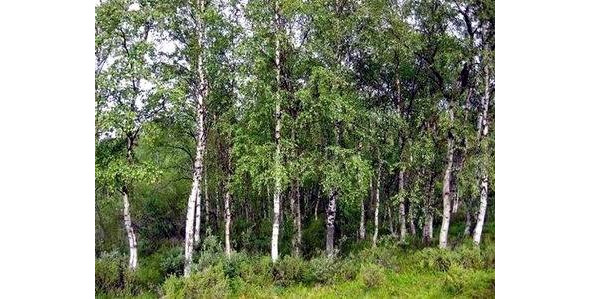
Birch trees. Canada
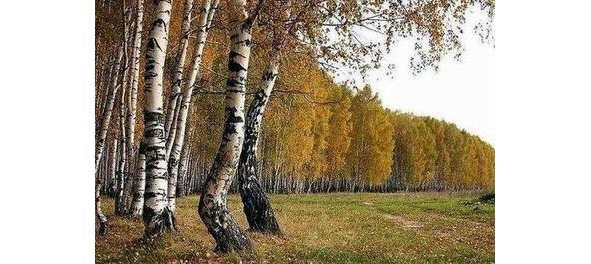
Birch trees. Russia
Moreover, the existing ones Due to the short time of isolation, the forms have probably not yet developed very divergingly. Indeed, we find such a correspondence that there is nothing better to wish for. So, in the Eocene we find almost everything suborders mammals in North America and also in Europe.
Similar distribution features are characteristic of other classes of animals.
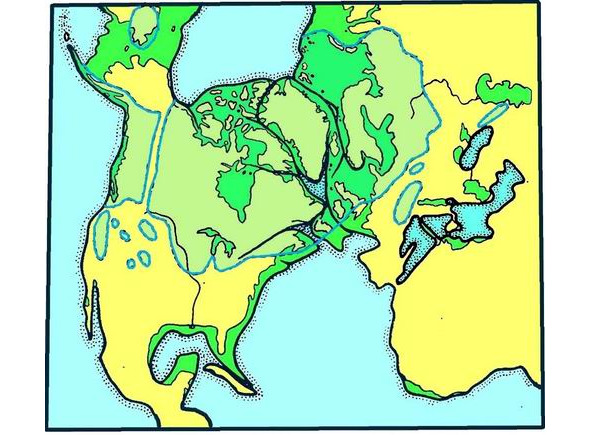
The boundaries of the spread of continental ice in the Quaternary period. For the time before the complete separation of North America from Europe. According to A. Wegener.
A young family of earthworms (Lumbricidae) is distributed from Japan to Spain, and on the other side of the ocean – only in the eastern United States. Barley is found on the edges of the former contact of the continents in Ireland and Newfoundland and in areas adjacent to these islands on both sides. The percidae family and other freshwater fish are found in Europe and Asia, and in North America only in the eastern part.

Pearl Oyster Newfoundland
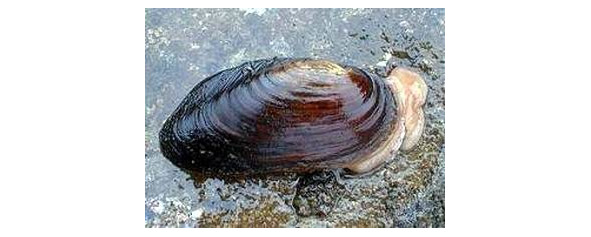
Pearl Oyster of Europe

Calluna uulgaris Newfoundland

Calluna uulgaris of Europe
Probably, one should also call the common heather (Calluna uulgaris), which is found in addition to Europe only on the island of Newfoundland and in the areas bordering it.
On the other hand, the distribution of a significant number of American plants is limited in Europe to the western part of Ireland. Although it is possible that the latter can be explained by the influence of the Gulf Stream; with regard to heather, such an explanation cannot be accepted. Especially noteworthy is the spread of field slugs from southern Germany through the British Isles, Iceland and Greenland all the way to the American side, where it, however, is found only on Labrador, Newfoundland.
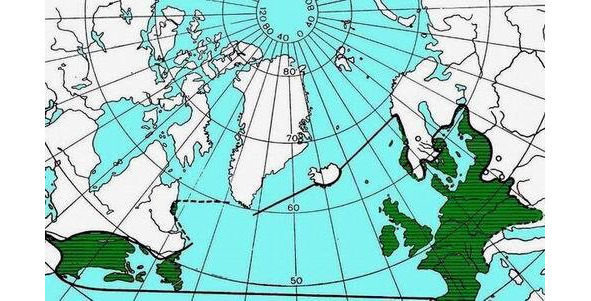
Field slug spread
V. A. Yashnov in his work on crustaceans of Novaya Zemlya indicates that the current distribution of freshwater crayfish is best explained by the theory of drift: «With high probability we can say that in hydrobiology many issues of the distribution of lower aquatic organisms, at least Hemispheres can be solved on the basis of the principles of the theory of movement of continents.As an example, we mention the modern scattered distribution of Limnocalanus macrurus, for which passive movement (by wind and birds) due to lack of «at the stages of dormancy.
In the presence of a combination of both continents, according to Wegener’s theory, the distribution range of these species becomes relatively small.»
What could be the reason for the division of the continent?
2
The plot of the liberation of the rivers by Indra as a result of the murder of the Vritra that bound or barred them (Vrtra – harbor, abundance, mountain, from the root of Vrti – shell, cover, obstacle) seems to be extremely interesting for science. It is believed that in the Avesta, Vritra is attested as an independent mythological character of Varabragna. Indra gave the earth a firm footing and at the same time freed the fettered waters and fired the fire enclosed in the hill of Vritra.
In the ordinary sense, rituals dedicated to this feat of Indra could probably be perceived in connection with the spring opening of the rivers, the liberation of the waters from the ice and snow that bound them and with spring floods. But if you think about this plot, then at the mythological level such an interpretation is contradicted by the simultaneity and univariance of the phenomenon, repeatedly emphasized in the Rig Veda and Mahabharata, its clear localization, attachment to a specific geographical region, as well as some circumstances that characterize the incident as extraordinary event.
Considering the main characteristics of the battle of Indra and Vritra, we must note that the time and place of this incident are indicated exactly. According to the Mahabharata, it happened in Crete South.
«The tribes of formidable, ferocious, frantic tribes of Danavas, nicknamed the Kalei, lived in Crete South. In the Vritra…» The chronology of kings and sages – rishis testifies to the same. Thus, according to the Puranas and the Mahabharata, immediately after the assassination of Vritra, King Nahush took the place of Indra until he was overthrown and Yayati became his heir. The Yayati era lasted more than a thousand years, the time of the reign of Nakhusha also amounted to a significant period. Meanwhile, Yayati was considered «mainly belonging to Crete-yuga», that is, part of his era went beyond its borders (possibly in the «twilight» of Crete-yuga). Crete-yuga, according to the total length of 12,000 years adopted in the Mahabharata, began over 10,800 years and ended 6400 years before the last Kali-yuga began in 3102 BC, i.e. between 13900 BC and 9500 BC And if we take into account only Crete South itself without «twilight» (400 years each), then since 13500 BC until 9900 BC But the defeat of Vritra was to happen at least 1—1.5 thousand years before the end of Crete-yuga, i.e. between 13500 BC and 10500—10000 BC.
The location of the battle of Indra and Vritra is also quite localized.
Firstly, the action took place in the north, since after the destruction of Vritra Indra hid in the south in the cool «Sea of Manas», which, according to the Puranas, is located south of Kailasy (a lake region south of the Pinega River).
Secondly: after the crash of Vritra, Indra «released seven streams for running» and «Manu flowed up billowing water.» Here, one should probably recall that one of the highest peaks of the Polar Urals is called Manaraga and the Manaraga River flows from it. (It is interesting that, according to legend, the 13 forefather of Manu attached his ship to the spur of one of the highest peaks of Himavat during the flood).
Thirdly: Vritra was considered a daitya and a Brahmin, but on the whole the east side was Brahmin, and Vritra lay on the great river. The river, which was located in the northeast, is also mentioned in Avesta as the «good Daitiya» adjacent to Ardvi-Sura (Northern Dvina) in Aryan Wedja. This river of daityas could well be called the «waters of Manu» among the Aryans. The only great river flowing in the northeast from the Urals near the Northern Dvina is Pechora, the tributary of which is the Manaraga River.
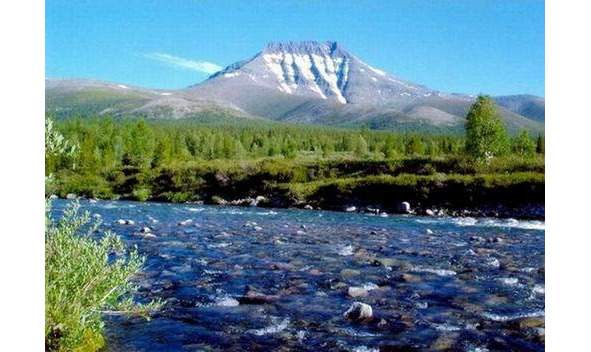
Mountain and river Manaraga
11 thousand BC – This is the end time of the continuous glaciation of the Far North of Eastern Europe. As paleogeographers note: «It was established that the degradation of the last ice sheet of the Pechora lowland, as well as of the entire north-east of the European territory of the USSR, occurred in an unusual way, fundamentally different from the degradation of the Scandinavian ice sheet… the destruction of the ice sheet was accompanied, and possibly caused by a process having a seismic nature, that is, earthquakes.» The question of how strong the earthquake must be to destroy the Pechora glacier with a thickness of up to 700 meters, and what caused it, paleogeographers leave open, but note that: «About 13.5 thousand years ago (i.e. 10,5 thousand BC) The Pechora valley lake was lowered and channels of permanent drains (Pechora and other rivers) formed along the loss of continuity zone, «the Barents Sea ice sheet collapsed, of which the Pechora glacier was a part.
Researchers’ conclusions seem to be extremely interesting: «according to the calculations… for a powerful glacier similar to the Antarctic to arise from a small glacier, it is required at temperatures typical for the Valdai maximum that is 14180 years. With a warm average Valdai or sea climate 16—17 thousand years. "These numbers can be compared with the following lines of the Mahabharata, which say that Vritra, «for the sake of strengthening strength, sixteen thousand years committed the killing of the flesh.»
It remains for us to ask the question: could the destruction of this North-East European glacier and the myth of Indra’s victory over Vritra be related to each other? Here is how Vritra is described in the Mahabharata: «Vrita, which covered itself with heaven and earth from all sides, was guarded by giants – kalaneys; when they waved their weapons, it seemed: the mountains were lifting their peaks.»
«Vritra said: Having appropriated the smells and tastes of various creatures of the slain, I thrived in three worlds. Framed with a radiant crown, I ruled in the heavens, invincible to all creatures, I never experienced fear.» The following fragment of Mokshadharma, telling about the meeting of the gods and Vritra, is especially striking: «Once Indra rode in a chariot surrounded by a somn of gods and saw him standing opposite the mountain-bearing Vritra. He went up five hundred yojanas, the destroyer of enemies, and over three hundred yojanas he was in girth.»
The horns of Vritra are also spoken of in the hymns of the Rig Veda:
«You, O Indra, this mountain, great, wide,
A club of thunder, oh thunderer, split into pieces
You released the bound waters for running. (RV. I, 57, 6).
In the secret of being secretly hidden in the waters
Secretly living, witching serpent,
Overlapping the water and the sky
You killed, O hero …»(RV. II, 11.5).
Chanting Indra, the hymns say that he «With force split the mountain, throwing vajra,» they constantly compare Vritra with the serpent «resting on the mountain», emphasize that he is «legless, armless, faceless.» These descriptions are not very suitable for spring snow or ice on rivers, but to a large extent correspond to the Barents Sea ice sheet.
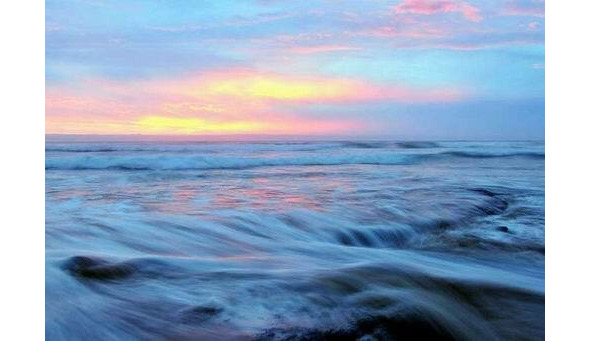
Ice shield
So the size of Vritra – mountains of 300 yojanas in a circle (4800 km.) corresponds to 1528 km. in length and width, which is equal to the established size of the Barents Sea ice sheet. The Barents Sea glacier occupied the entire shelf of the Barents Sea, the Kara Sea, the Bolshezemelskaya and Malozemelskaya tundra, adjoined the Scandinavian and Kara shields and had an area of 2.1 million km, an ice thickness of up to 3.5 km (an average of 1.870 km.) And an ice volume of 4 million cubic km.
An altitude of 500 yojanas (8,000 km.) May mean that something happened at that altitude. In this regard, a fragment of Indra’s anthem (PB. IV, 17), which speaks of his birth, is very interesting:
«The sky shook from the flash at your birth,
The earth shook with fear of your fury.
Strong mountains swayed
Deserts parted, water flows…
When you are born, you are first of all
He terrified all these peoples, O Indra.
Snake damming stock
You cut the vajra, oh generous.»
The same hymn says that Indra «set in motion the wheel of the sun», he stopped the sage Etasha, who ran through the sky, and threw him, furious, «to the bottom of the hide, dark space, into his bosom», i.e. into the depths of the earth.
The further description of the battle is extremely interesting. After a meeting at an altitude of 500 yojan: «from the skies of Vtyra, a hail of stones fell upon the lord of the gods with lightning speed, and the angry crowds of the gods began to shoot arrows, stone rain everywhere, beating off, brought down by Vritra in battle.»
When the battle of the gods and the Danavs, the defenders of Vritra began to boil, then «it was visible… how the heads fell from the heavens, like fruits ripped from cuttings… Armed with clubs, with iron spikes of kalea, gold armor, they were approaching the gods, as if covered the flames of a mountain forest fire. «But Vritra did not help «neither lightning, nor thunder, nor the fog that he spread, nor hail» – the gods moved south to the Sarasvati River, and then returned, armed with a heavenly thundering mace – the vajra, and:
«When Indra and the Serpent Fought
For (all) future times, generous defeated.»
Already as Indra returned and the host of gods with a blazing vajra to continue the battle with Vritra, the last «fever» penetrated and completely enveloped him. «He was terribly pale, his mouth was inflamed, a strong trembling gripped his body, his breathing became very frequent, his body hair rose, he breathed quickly and hard… A blazing flame burst from his sides in a fire…»
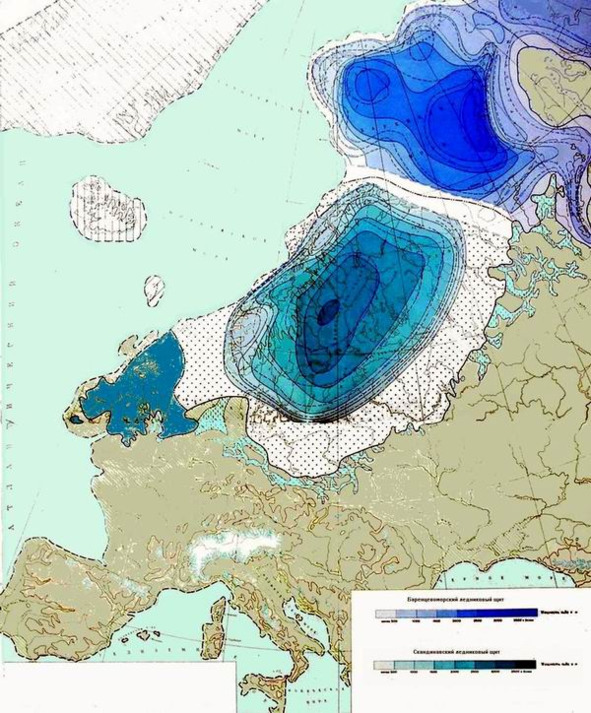
Valdai Glaciation
«Vritra erupted in terrible screams. The sides of the world, the firmament, the heavens, the earth and mountains trembled from his roar» and when «the inhuman cry of that great asura sounded: he opened his throat, (he shouted), gripped by a heavy fever… into his open mouth perun pierced the Chakra; the brilliance of that perun was very bright, it’s dying like a flame. Instantly, the huge body of Vritra’s smoke fell. "So, Indra’s celestial mace «forcefully chopped off the head of Vritra, who oppressed both worlds», as a result of which Vritra sank to the «bottom of space», and «the earth increased tenfold» and «the peoples could spread on it».
Thus, the great battle of Indra and Vritra, which was simultaneously taking place both in heaven and on earth, ended with the fact that «this mountain, the great, wide, with a club of thunder (Indra) … broke into pieces» and «released the bound water for running», he» drilled water (channels) … cut through the bowels of the mountains… how moo cows, rushing straight to the sea, run off the waters … (he) released seven streams for running… Through lifeless lying like crumbled reed (Vritra), flowing, billowing water Manu.»
Vritra himself, «faceless from the breach… crushed, lay scattered in different places.» It is characteristic that the nature of the relief has also changed.
«The land was stretched exactly, even the mountain, trying to escape, stopped. The mountain settled down, not dodging.»
It is interesting that it was 12 thousand years ago (i.e., at the turn of 11—10 thousand BC) that the Earth’s geomagnetic field changed.
We can assume that the myth of the battle of Indra and Vritra describes the interaction of a glacier with a space body. Moving at an altitude of 500 yojanas (8000 km.), It for some reason sharply braked and approached the Earth. At this time, probably, the breakaway parts fell and as a result of the impact of a sharp tidal wave and the rise of the earth’s crust, an earthquake occurred, volcanic activity began. Deviating to the southwest, the space object pushed a small cosmic body from its orbit over the Central Russian Upland (or a piece broke off from it).
The following lines of the Mahabharata also testify to the rotation of such a body in Earth orbit: «By that unbreakable, irresistible perun, arising from the Brahmin bones, penetrated by Vishnu, Indra killed Vishvaruna and cut off his head.
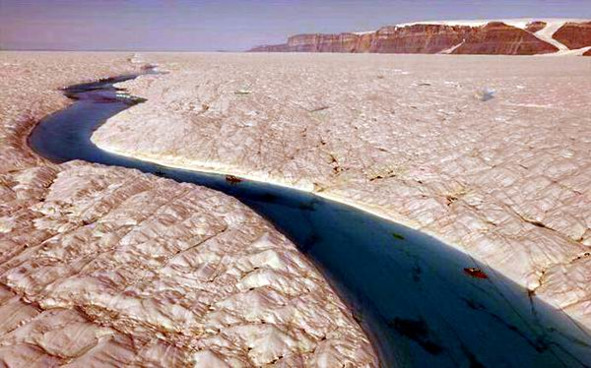
Rivers on a glacier
Immediately after this son of Tvashtar, who arose from the fragmented body of Vishvaruna, Indra killed the enemy. «But this «directly» judging by the fact that Vritra existed for at least 16 thousand years, lasted quite a long time, and all this time the «Vajra» rotated in low Earth orbit. As the space object returned to its orbit and the Vajra approached the glacier, tectonic vibrations, volcanism, and glacier bombardment by meteorites intensified. Because of them, cracks went through the massif, intensive melting began, fog from the vapors rose above the glacier, and fire fell on its foot. At the same time, the roar of volcanoes was blocked by a whistle from the falling «Vajra» («noisy club of thunder»). With thunder and thunder, returning, it crashed from the southwest into the body of the glacier, finally breaking a single mass of ice. The fragments from it, bounced off the surface, scattered in different directions, subjecting the glacier to additional bombardment, because «Vajra» «scattered into hundreds of pieces on the head of Vritra.» As a result of tectonic changes, part of the surface in the Barents Sea was lowered and the existing mountain ranges were destroyed.
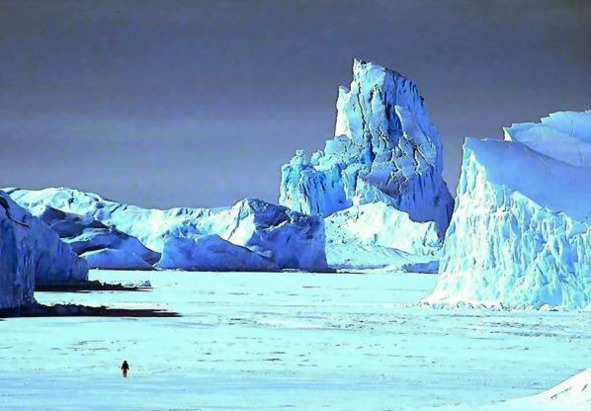
Glacier
Paleogeographers note a number of features of this region. «A characteristic feature of the history of this (Barents Sea) cover was the very rapid rate of decay, which began, however, relatively late,» and had the appearance of destruction and fragmentation of the glacier. As noted above, detailed studies have shown that «the degradation of the last ice sheet of the Pechora lowland, as well as the entire North-East of the European territory of the USSR, occurred in an unusual way, fundamentally different from the degradation of the Scandinavian ice sheet. Its destruction was accompanied, and possibly caused by the process, seismic in nature, i.e. earthquakes». But the power of these earthquakes had to reach at least 12 points in the vast area from Pechora to Spitsbergen; otherwise they simply would not have been able to destroy a glacier with an area of 2 million square kilometers with 4 million cubic kilometers of ice. In modern science, the question remains open, what could have caused such catastrophic earthquakes in this tectonically calm area, moreover, balanced then by three kilometers of ice, dampening fluctuations in the lithosphere crust (the glacioisostatic trough reached at least 150—170 m.). In the edge part of the glacier, the ice thickness was also significant – not less than 450—700 m.
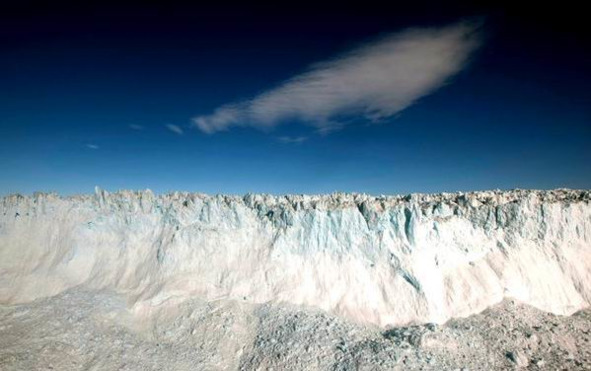
The edge of the glacier
The answer proposed by the Mahabharata and the Rig Veda in the form of a double effect of tidal disturbance from a space object and the fall of fireballs explains this.
The question of the time of the final destruction of the Barents Sea glacier is somewhat more complicated. Thus, a number of researchers believe that the final melting of the glacier on the Pechora occurred after 8 thousand BC, which is associated with the descent of a valley lake that existed at the mouth of the Pechora River in 7400—7200 BC and carried out flow through Sula and Indiga into the sea.
But, firstly: if there was a runoff into the Barents Sea, it means that there was no continuous ice on the sea, and secondly: the river could be blocked both by a residual mountain glacier and as a result of a local tectonic uplift.
Other researchers believe that evidence of the existence of a glacier at the turn of 7—8 thousand BC there are traces of moraines, as well as the dating of buried vegetation in the layers of the Markhid moraine 7—6.7 thousand BC by C14.
But, under them lies woody vegetation of 8 thousand BC, that is, at least at this time, a forest grew in the mouth of the Pechora. As indicated in the 20"Paleogeography of Europe over the last hundred thousand years», moraine formations of «dead» ice, covered with sediment on top, in the blades of glaciers reaching 250 meters in height, could exist even covered with vegetation for at least 3.5 thousand years.
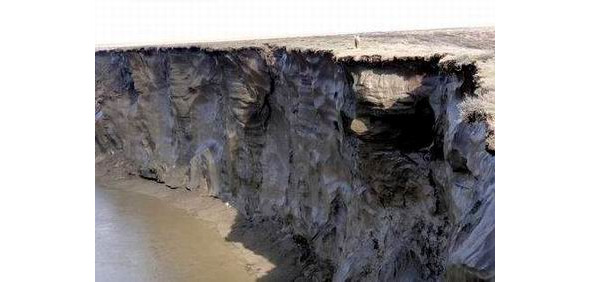
Moraine formations from dead ice
It is noted that in the postglacial period catastrophic mudflows were widespread even in the valleys, and most of the «moraine» formations 15 km long and 1 km wide were attributed to them. In addition, carbon dating for this time (8 thousand BC) is rejuvenated by 1—1.5 thousand years compared to the present age.
According to the latest data, the destruction of the Pechora glacier occurred 12.5
thousand years ago, i.e. in 10—11 thousand BC. Then, in 10—11 thousand BC, a glacier disappeared in Western Siberia, which was part of the same ice sheet with Pechorsky.
The fact that the events described that according to the Mahabharata after the destruction of Vritra, after a long period of time, in order to get rid of the Danavas, the Northwest Ocean was drained moreover, his condition lasted at least 3 millennia.
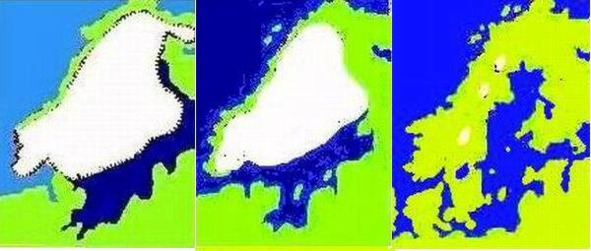
Baltic glacial lake – The Yoldian Sea – Litorin Sea
Meanwhile: «on the border of the Allered and the Upper Dryas, the Baltic glacial lake itself is formed. In the beginning, it had a limited connection with the ocean, but after a catastrophic descent north of Mount Billingen, the reservoir level dropped by 25—30 meters and ocean waters penetrated the Baltic.
This event occurred after the formation of the second ridge of Salpausselkä, according to varvametric and radiocarbon data, it dates back to 8.3 thousand BC.
The invasion of the ocean led to the creation of a brackish basin, known as the Yoldian Sea. It occupied only the central part of the Baltic Basin, southwestern and southern regions were in subaerial conditions. (At the same time, water slept in the reservoirs between the Baltic and the White Sea, connecting these seas). Low sea levels persisted until the litorin transgression in 5.2—4.7 thousand BC, when the warm Litorin Sea arose».
The findings of the researchers, according to which a glacier similar to the Pechora and Barents Sea could not melt, appear to be extremely interesting.
Having reached the maximum, the glacier in the modern climate would have been melting for at least 50 thousand years (that is, we would still have the opportunity to observe ice sheets throughout the north). At temperatures 2° C higher than modern ones (i.e., the Holocene optimum), it would melt for 10 thousand years, while such temperatures should have persisted above the glacier itself during the ice age. With the actual temperature increase at the end of the Ice Age by 5—6° C from the Valdai maximum, the glacier would remain stable, since a further increase in temperatures would not allow the presence of a thick ice sheet, and melting would compensate for the mass gain due to increased precipitation. Thus, the Pechora and Barents Sea glaciers could not melt by themselves.
The only possibility of melting was that the system had to be brought out of stability by an external influence, moreover, long enough (which is not observed), or powerful enough (which is observed both according to sources and according to paleogeography data). We should be glad that the asteroid (satellite) fell so successfully that it destroyed the glacier, because if it got into a plastic ice mass capable of absorbing the energy of an impact, but into the ocean or on land, the consequences for humanity could be extremely unfavorable. After all, a piece of a comet with a diameter of 5 km. was able to cause a catastrophe even on Jupiter (the impact power reached 1 trillion Hiroshim), what can we say about the Earth.
The ice sheet in the Northern Hemisphere has melted very quickly, according to information obtained from drilling ice in Greenland, for a period of less than a year, maybe for months or days. Sure, water flows resulting from this flood, rushing south (along the valleys of the Volga, Don, Dnieper, Mississippi) on their way inflicted huge damage on the ecosystem, but, nevertheless, they created a modern world. The starting point of this process is described in the Rig Veda and Mahabharata. And in the reality of these observations there is no doubt.
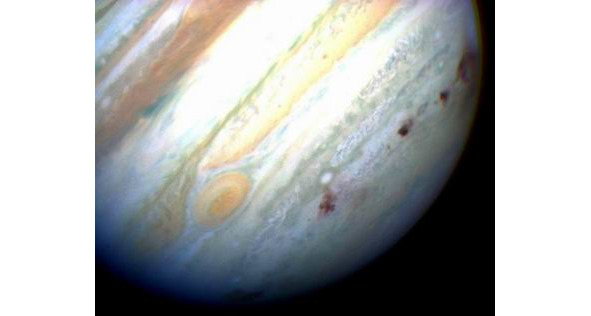
Fall of the comet on Jupiter
